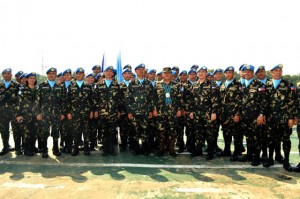Seventy-five Filipinos serving in the United Nations peacekeeping force in the Golan Heights are locked in a standoff with Syrian armed groups, some of them linked to al-Qaeda, Philippine military officials said on Friday.
The United Nations earlier reported that the gunmen captured 43 peacekeepers from Fiji on the Syrian side of the Golan Heights on Thursday.
The Fijians were forced to surrender their weapons and taken hostage near the Quneitra crossing but the Filipino blue helmets “held their ground” and refused to disarm, Armed Forces spokesman Maj. Gen. Domingo Tutaan told reporters.
“Our soldiers are prepared, brave and capable of dealing with this situation and will take risk to fulfill our commitment to security and peace,” Tutaan said.
The contingent “has the right to defend its position and the limits in line with the UN protocols on rules of engagement,” he added.
Military and defense officials were in close coordination with the United Nations Disengagement Force (UNDOF) and in direct communication with the peacekeepers, Tutaan said.
The UNDOF supervises the Golan Heights, which separates Syria and Israel in line with the disengagement agreement in 1974.
Col. Roberto Ancan, commanding officer of the Armed Forces of the Philippines Peacekeeping Operations Center, said 40 Filipino troops were holding out in “Position 68” and 35 in “Position 69.”
The positions were some four kilometers away from each other, Ancan added.
The troops were armed with M4 assault rifles, M60 light machineguns, a K3 automatic rifle and a .45 caliber pistol.
They were equipped with bullet-proof vests and Kevlar helmets, Ancan said.
“I would just like to emphasize that our troops there are well-armed and well-trained. They also have their own organizational training once they are deployed and they are well-disciplined peacekeepers,” he added.
The Filipinos were “being directed to stand their ground in the area to avoid escalation,” Ancan said.
The UN force commander in the Golan Heights is an Indian with the rank of major general, he added.
President Benigno Aquino 3rd described the situation in the Golan Heights as “tense” but also sought to calm fears about the fate of the Filipino troops.
“So far, we should not worry. The news is that the situation looks stable,” Aquino said.
Fiji army chief Brigadier-General Mosese Tikoitoga said the captured peacekeepers were all safe, and asked people in the Pacific nation to pray that they are released unharmed.
“(The) men are safe and well even though they are detained by armed rebels in the Golan region,” he told reporters in the capital Suva.
Syrian rebels, including fighters from the al-Qaeda affiliate al-Nusra Front, stormed the crossing at Quneitra on Wednesday, sparking an exchange of gunfire with Israeli troops.
Quneitra is the only crossing between the Syrian and the Israeli-controlled side of the strategic plateau.
The UN Security Council “strongly condemned” the detention of the 43 and the “surrounding of positions” manned by the 81 other peacekeepers, by “terrorist groups and by members of non-state armed groups.”
The council demanded the “unconditional and immediate release of all the detained United Nations peacekeepers” and urged countries with influence to help win their release.
The Filipinos were locked in a standoff near Ar Ruwayhinah and Burayqah, while the Fijian soldiers were taken to the southern part of the buffer zone, UN officials said.
UN spokesman Stephane Dujarric said it was unclear which group had staged the attacks.
“Some groups are self-identified as affiliated to al-Nusra but we are not able to confirm,” he added.
The US State Department pointed the finger at al-Nusra, however.
“The United States strongly condemns the detention of UN peacekeepers and ongoing violence targeting the UN Disengagement Observer Force (UNDOF) in the Golan Heights by non-state armed groups, including UN Security Council-designated terrorist group al-Nusra Front,” US State Department spokeswoman Jen Psaki said in a statement.
Washington demanded the “unconditional and immediate release” of the blue helmets.
UN officials noted that peacekeepers monitoring the armistice line between Israel and Syria were detained twice last year before being released safely.
In June 2013, there was a similar takeover of the crossing by rebel forces, but the Syrian army managed to regain control.
Six countries contribute troops to the 1,200-strong UNDOF: Fiji, India, Ireland, Nepal, the Netherlands and the Philippines.
The Philippines, which has 331 troops serving in UNDOF, announced last Saturday it will pull out of the peace force, citing security concerns.
Philippine defense officials said no fresh troops would be sent to serve in UNDOF once the current batch of soldiers returns from duty in October.
Last year, Manila also considered pulling its Golan peacekeepers out after 25 of them were kidnapped but later freed by Syrian rebels in two separate incidents.
A Filipino soldier was also wounded by a wayward shell last year.
Since the Syrian conflict erupted in 2011, the plateau has been tense, with a growing number of rockets and mortar rounds hitting the Israeli side, mostly stray, prompting occasional armed responses.
During fighting on Wednesday, several mortars landed in or near UN positions.
Israel, which is yet to sign a peace deal with Syria, seized 1,200 square kilometers of the Golan Heights during the 1967 Six-Day War and later annexed it in a move never recognized by the international community.
The UNDOF has maintained presence there since 1974 to supervise the implementation of the Agreement on Disengagement and to maintain a ceasefire in the area of separation known as the UNDOF Zone.
Syria and Israel have not used overt military force since 1974, although the area has been tensed when the 2011 Syrian conflict hit and rocked the Israeli side with stray mortar rounds and rockets.
WITH REPORTS FROM CATHERINE S. VALENTE AND BERNICE CAMILLE V. BAUZON


